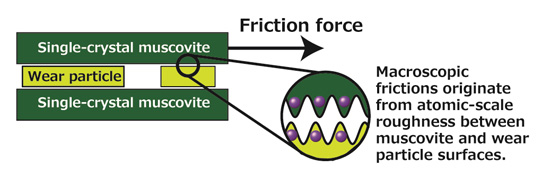Identifying the Origin of Macroscopic Friction between Clay Mineral Surfaces
—Friction Explained in Terms of Interatomic Electrostatic Force May Facilitate Understanding of Fault Movement Mechanisms—
2018.12.19
National Institute for Materials Science
University of Tokyo
Hiroshima University
NIMS, the University of Tokyo and Hiroshima University jointly discovered for the first time, through theoretical calculation and experiment that macroscopic frictions occurring between clay mineral surfaces originate from interatomic electrostatic forces between these surfaces.
Abstract
- NIMS, the University of Tokyo and Hiroshima University jointly discovered for the first time, through theoretical calculation and experiment that macroscopic frictions occurring between clay mineral surfaces originate from interatomic electrostatic forces between these surfaces. This finding may facilitate the design of solid lubricant materials and understanding of earthquake-causing fault slip mechanisms.
- Frictional forces between the surfaces of layered crystals, such as clay minerals, are generally low. This property is thought to be a cause of landslides and fault movements in nature. Active efforts have been made in research on friction to develop friction-reducing solid lubricants and for other purposes. Origin of Friction between clay mineral surfaces had been thought to be induced by some sorts of bonding forces; however, these forces were not understood in detail due to complex influences of electrostatic and intermolecular forces between clay mineral surfaces, crystallographic orientation differences between these surfaces, surface roughness and the presence of impurities.
- This joint research team studied muscovite—a layered clay mineral—with flat and smooth surfaces at the atomic level. The team first removed moisture from the space between the muscovite surfaces (20 cm x 40 cm in area) by applying high pressure under dry conditions. The team then measured frictional forces between the muscovite surfaces at different sliding positions. As a result, the team observed wear particles produced from worn muscovite surfaces and found that these particles may have nullified the effect of crystallographic orientation on frictional forces. The team also determined the frictional forces generated by estimating interatomic electrostatic forces between contacting surfaces using quantum mechanical calculations, assuming that the effect of crystallographic orientation on frictional forces is null. The calculated frictional forces nearly perfectly matched experimental results. Thus, the research team confirmed for the first time that frictions occurring between the surfaces of clay minerals of tens of centimeters in size are controlled by atomic-scale electrostatic forces.
- In future studies, we hope to develop a theory that will explain frictional strength in a broad range of clay minerals, in addition to muscovite. Such theory may provide material design guidelines for friction-reducing solid lubricants and other friction-related products.
- This research project was carried out by a research team consisting of Hiroshi Sakuma (Senior Researcher, Research Center for Functional Materials, NIMS), Shigeru Suehara (Principal Researcher, International Center for Materials Nanoarchitectonics, NIMS), Kenji Kawai (Associate Professor, School of Science, University of Tokyo) and Ikuo Katayama (Professor, Graduate School of Science, Hiroshima University).
This work was supported by the MEXT Grant-in-Aid for Scientific Research on Innovative Areas titled “Crustal dynamics: unified understanding of intra-island deformation after the Great Tohoku-oki Earthquake” (grant numbers JP17H05320 and JP15H01145) and the JSPS Grant-in-Aid for Scientific Research (grant number JP15H02147). - This study was published in Science Advances at 2:00 pm on December 21, 2018, local time (4:00 am on December 22, Japan Time).

Related files
- Research Center for Functional Materials
Contacts
(Regarding this research)
-
Hiroshi Sakuma
Senior Researcher
Research Center for Functional Materials
National Institute for Materials Science
Tel: +81-29-860-4942
E-Mail: Sakuma.Hiroshi=nims.go.jp
(Please change "=" to "@") -
Kenji Kawai
Associate Professor, Department of Earth and Planetary Science
School of Science, University of Tokyo
Tel: +81-3-5841-4310
E-Mail: kenji=eps.s.u-tokyo.ac.jp
(Please change "=" to "@") -
Ikuo Katayama
Professor, Department of Earth and Planetary Systems Science
Graduate School of Science, Hiroshima University
Tel: +81-82-424-7468
E-Mail: katayama=hiroshima-u.ac.jp
(Please change "=" to "@") -
Shigeru Suehara
Principle Researcher
International Center for Materials Nanoarchitectonics
National Institute for Materials Science
Tel: +81-29-860-4350
E-Mail: SUEHARA.Shigeru=nims.go.jp
(Please change "=" to "@")
(For general inquiries)
-
Public Relations Office
National Institute for Materials Sciences
Tel: +81-29-859-2026
Fax: +81-29-859-2017
E-Mail: pressrelease=ml.nims.go.jp
(Please change "=" to "@") -
Public Relations Office
Graduate School of Science, University of Tokyo
7-3-1 Hongo, Bunkyo-ku, Tokyo 113-0033, Japan
Tel: +81-3-5841-0654
E-Mail: kouhou.s=gs.mail.u-tokyo.ac.jp
(Please change "=" to "@") -
Department of Public Relations
Financial and General Affairs Office, Hiroshima University
1-3-2 Kagamiyama, Higashi-Hiroshima City, Hiroshima 739-8511, Japan
Tel: +81-82-424-3749
Fax: +81-82-424-6040
E-Mail: koho=office.hiroshima-u.ac.jp
(Please change "=" to "@")
Recent Press Release
-
Simultaneous Imaging of Intracellular DNA and RNA Using Harmless Light
2025.10.27
-
Development of an AI Device Using Ion Gel and Graphene That Dramatically Streamlines Machine Learning Computations
2025.10.14
-
Demonstrating a Novel Method to Modulate Heat Flow Through the Collective Motion of Spins
2025.10.06
